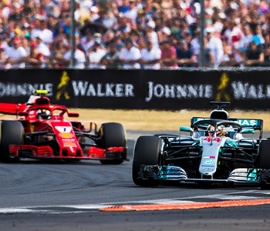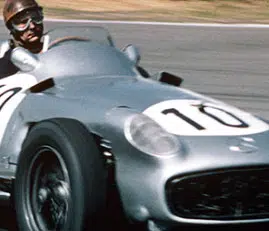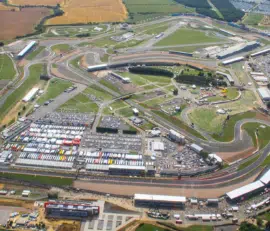With a race of the nature of the 1,000-kilometres at Nurburgring the practice periods are more in the nature of proving and testing periods than practice as applied to a Grand Prix race. The Nurburgring, with its 22.81 kilometres of twists and turns, demands the utmost from drivers and cars, and a race over 1,000 kilometres requires careful attention to such things as suitability of car, pairing of drivers, tyre and fuel consumptions, pit work and general long-distance race tactics. In consequence there were two and a half days of training before the race, and though many people put great store on lap times recorded, they bore little or no relationship to the ultimate structure of the race. While a very fast lap showed the prowess of the driver and the performance of the car, it was continuous lap speeds that were of more interest to the team managers. With the race counting towards the Manufacturers’ Championship and all the big works teams competing, it was rather a waste of time following the detailed movements of any particular team, for what happened in practice, in many cases, bore no resemblance to the activities or arrangements for the actual race.
On paper the race looked to be a walk-over for Maserati, with Fangio and Moss teamed together in one of the fabulous 4.5-litre V8 cars, and though there was opposition from Ferrari, Aston Martin, Jaguar and Porsche, none seemed likely to be able to challenge the Scuderia Maserati. During training Fangio twice recorded laps in 9 mm. 43 sec., a bare two seconds off the Formula 1 lap record, while Moss was content to lap around 9 min. 50 sec. The real eye-opener was the new Aston Martin DBR1/300 which Brooks took round in an effortless 9 min. 48 sec., a seemingly impossible speed for any Aston Martin, even the new one. Apart from Brooks’ superb driving and uncanny natural ability, the new chassis seemed ideally suited to the Nurburgring and the 240 b.h.p. was just enough, so that it could be used all the time. In contrast, the big Maserati with its 400 b.h.p. meant that the drivers were being continually troubled with too much power for the circuit, especially on the twisty parts. The works Ferraris were also having this trouble, and it was found that most of their drivers were little slower in an experimental car fitted with a relatively woolly Gran Turismo engine.
It was interesting to note during training how the various teams tackled the problems of letting their drivers learn the difficult circuit, adjust their cars to conditions, sort out the best combinations of drivers and cars, and generally tackle the innumerable problems that must be solved before setting off to race for 1,000 kilometres. The Scuderia Maserati had two 4.5-litre cars, the ill-fated Moss car that did only 12 kilometres in the Mille Miglia, the original 1957 one that Behra crashed before the Mille Miglia, now completely rebuilt, the experimental V12-cylinder 3.5-litre that Herrmann drove in the Mille Miglia, the 300S 3-litre with brakes from a 4.5-litre car, that Scarlatti drove into fourth place in the Italian race, and a standard 3-litre belonging to the Spaniard Godia. The drivers for this assorted array of powerful machinery were Fangio, Moss, Schell, Herrmann, Bonnier, Scarlatti, Godia and Gould. The Scuderia Ferrari replied with two V12-cylinder Mille Miglia cars, one a 4½-litre and the other a 3.8-litre, the works 250 G.T. Europa that Gendebien has been driving so well just lately, and a new car. This latter was in the nature of an experiment, having a chassis based on a cross between the production Testa Rosa 2-litre and the works V12 cars, but fitted with an engine and gearbox unit from a Gran Turismo Europa 3-litre V12. The rear of this car was new in that it was de Dion following normal Ferrari design, but the gearbox was not in unit with the differential unit but mounted on the rear of the engine. The chassis frame was lighter than previous Ferrari models, and the whole car was small and compact for a 3-litre. Front suspension was the normal double-wishbones and coil-springs, as used on all Ferrari sports cars, while a transverse leaf-spring controlled the de Dion rear layout. Lined up to drive the Maranello cars were Hawthorn, Collins, von Trips, Trintignant, Gendebien, Gregory, and Morolli, the last named being from the Osca team. The Aston Martin team were fresh from their victorious outing at Spa and had the same two DBR1/300 models, these having a chassis layout based on the experimental 2½-litre car that ran at Le Mans last year, using dry-sump 3-litre engines. The chassis frame was a small-diameter tube space-frame, front suspension by trailing arms and torsion bars, rear suspension by de Dion with a Watt-link location for the de Dion tube, and the five-speed gearbox in unit with the differential/rear axle assembly. There was also one of last year’s DB3S works cars fitted with an experimental front suspension utilising double-wishbones and coil-springs, a system tried out on a saloon last winter. As a spare and practice car there was a further 1956 works DB3S which was quite standard, and the team of drivers were Brooks, Salvadori, Leston, Cunningham-Reid and the Whiteheads, P. N. and A. G. With no official Jaguar team competing this year Coventry hopes were in the capable hands of the Ecurie Ecosse, using two of the long-nose 1956 works D-types and their own 1956 Le Mans-winning car. Their list of drivers read: Flockhart, Sanderson, Lawrence, Fairman, Bueb and Steed. Also with a D-type Jaguar were H. C. Taylor and Scott-Brown, these two being entered by Murkett Brothers, who own the car. To complete this imposing array of large-capacity sports cars were two privately-owned Ferraris, one a 3-litre Monza and the other a 2-litre Testa Rosa, but though this lot provided more than enough competitors to make an exciting race, there were many more smaller cars and a vast list of Gran Turismo cars, for the A.D.A.C. continue the dangerous practice of mixing relatively slow production G.T. saloons with works racing/sports cars. The 1,500-c.c. sports group contained two works Porsches, two Fitzwilliam alloy-bodied M.G.s, private Porsche Spyders and three Loti, as well as two Oscas and a Maserati. The big Gran Turismo group was dominated by a row of 300SL Mercedes-Benz, while the medium-sized class contained innumerable Porsche Carreras and two standard M.G. MGAs from the Fitzwilliam team, while the small group was dominated by Alfa-Romeo Giulietta Sprint Veloces.





